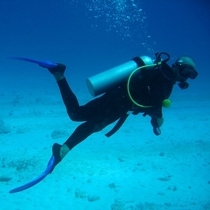
Scuba diving
Scuba diving is a mode of underwater diving whereby divers use breathing equipment that is completely independent of a surface air supply. The name "scuba", an acronym for "Self-Contained Underwater Breathing Apparatus", was coined by Christian J. Lambertsen in a patent submitted in 1952. Scuba divers carry their own source of breathing gas, usually compressed air, affording them greater independence and movement than surface-supplied divers, and more time underwater than free divers. Although the use of compressed air is common, a gas blend with a higher oxygen content, known as enriched air or nitrox, has become popular due to the reduced nitrogen intake during long and/or repetitive dives. Also, breathing gas diluted with helium may be used to reduce the likelihood and effects of nitrogen narcosis during deeper dives. Open circuit scuba systems discharge the breathing gas into the environment as it is exhaled, and consist of one or more diving cylinders containing breathing gas at high pressure which is supplied to the diver through a diving regulator. They may include additional cylinders for range extension, decompression gas or emergency breathing gas. Closed-circuit or semi-closed circuit rebreather scuba systems allow recycling of exhaled gases. The volume of gas used is reduced compared to that of open circuit, so a smaller cylinder or cylinders may be used for an equivalent dive duration. Rebreathers extend the time spent underwater compared to open circuit for the same gas consumption; they produce fewer bubbles and less noise than open circuit scuba which makes them attractive to covert military divers to avoid detection, scientific divers to avoid disturbing marine animals, and media divers to avoid bubble interference. Scuba diving may be done recreationally or professionally in a number of applications, including scientific, military and public safety roles, but most commercial diving uses surface-supplied diving equipment when this is practicable. Scuba divers engaged in armed forces covert operations may be referred to as frogmen, combat divers or attack swimmers. A scuba diver primarily moves underwater by using fins attached to the feet, but external propulsion can be provided by a diver propulsion vehicle, or a sled pulled from the surface. Other equipment needed for scuba diving includes a mask to improve underwater vision, exposure protection by means of a diving suit, ballast weights to overcome excess buoyancy, equipment to control buoyancy, and equipment related to the specific circumstances and purpose of the dive, which may include a snorkel when swimming on the surface, a cutting tool to manage entanglement, lights, a dive computer to monitor decompression status, and signalling devices. Scuba divers are trained in the procedures and skills appropriate to their level of certification by diving instructors affiliated to the diver certification organisations which issue these certifications. These include standard operating procedures for using the equipment and dealing with the general hazards of the underwater environment, and emergency procedures for self-help and assistance of a similarly equipped diver experiencing problems. A minimum level of fitness and health is required by most training organisations, but a higher level of fitness may be appropriate for some applications.
See all
0
0
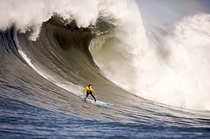
Surfing
Surfing is a surface water sport in which an individual, a surfer (or two in tandem surfing), uses a board to ride on the forward section, or face, of a moving wave of water, which usually carries the surfer towards the shore. Waves suitable for surfing are primarily found on ocean shores, but can also be found in standing waves in the open ocean, in lakes, in rivers in the form of a tidal bore, or in wave pools. The term surfing refers to a person riding a wave using a board, regardless of the stance. There are several types of boards. The Moche of Peru would often surf on reed craft, while the native peoples of the Pacific surfed waves on alaia, paipo, and other such water craft. Ancient cultures often surfed on their belly and knees, while the modern-day definition of surfing most often refers to a surfer riding a wave standing on a surfboard; this is also referred to as stand-up surfing. Another prominent form of surfing is body boarding, where a surfer rides the wave on a bodyboard, either lying on their belly, drop knee (one foot and one knee on the board), or sometimes even standing up on a body board. Other types of surfing include knee boarding, surf matting (riding inflatable mats) and using foils. Body surfing, in which the wave is caught and ridden using the surfer's own body rather than a board, is very common and is considered by some surfers to be the purest form of surfing. The closest form of body surfing using a board is a handboard which normally has one strap over it to fit on one hand. Three major subdivisions within stand-up surfing are stand-up paddling, long boarding and short boarding with several major differences including the board design and length, the riding style and the kind of wave that is ridden. In tow-in surfing (most often, but not exclusively, associated with big wave surfing), a motorized water vehicle such as a personal watercraft, tows the surfer into the wave front, helping the surfer match a large wave's speed, which is generally a higher speed than a self-propelled surfer can produce. Surfing-related sports such as paddle boarding and sea kayaking that are self-propelled by hand paddles do not require waves, and other derivative sports such as kite surfing and windsurfing rely primarily on wind for power, yet all of these platforms may also be used to ride waves. Recently with the use of V-drive boats, Wakesurfing, in which one surfs on the wake of a boat, has emerged. As of 2023, the [https://www.guinnessworldrecords.com/news/2022/5/sebastian-steudtner-surfs-giant-wave-and-smashes-world-record-705874 Guinness Book of World Records] recognized a wave ride by Sebastian Steudtner at Nazaré, Portugal as the largest wave ever surfed. During the winter season in the northern hemisphere, the North Shore of Oahu, the third-largest island of Hawaii, is known for having some of the best waves in the world. Surfers from around the world flock to breaks like Backdoor, Waimea Bay, and Pipeline. However, there are still many popular surf spots around the world: Teahupo'o, located off the coast of Tahiti; Mavericks, California, United States; Cloudbreak, Tavarua Island, Fiji; Superbank, Gold Coast, Australia. In 2016 surfing was added by the International Olympic Committee (IOC) as an Olympic sport to begin at the 2020 Summer Olympics in Japan. The first gold medalists of the Tokyo 2020 surfing men and women's competitions were, respectively, the Brazilian Ítalo Ferreira and the American from Hawaii, Carissa Moore.
See all
0
0
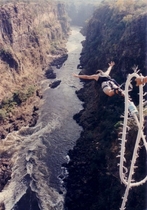
Bungee jumping
Bungee jumping , also spelled bungy jumping, is an activity that involves a person jumping from a great height while connected to a large elastic cord. The launching pad is usually erected on a tall structure such as a building or crane, a bridge across a deep ravine, or on a natural geographic feature such as a cliff. It is also possible to jump from a type of aircraft that has the ability to hover above the ground, such as a hot-air-balloon or helicopter. The thrill comes from the free-falling and the rebound. When the person jumps, the cord stretches and the jumper flies upwards again as the cord recoils, and continues to oscillate up and down until all the kinetic energy is dissipated.
See all
0
0
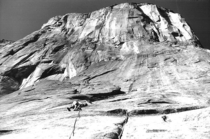
Rock climbing
Rock climbing is a sport in which participants climb up, down or across natural rock formations or artificial rock walls. The goal is to reach the summit of a formation or the endpoint of a usually pre-defined route without falling. Rock climbing is a physically and mentally demanding sport, one that often tests a climber's strength, endurance, agility and balance along with mental control. Knowledge of proper climbing techniques and the use of specialized climbing equipment is crucial for the safe completion of routes. Because of the wide range and variety of rock formations around the world, rock climbing has been separated into several different styles and sub-disciplines, such as scrambling, another activity involving the scaling of hills and similar formations, differentiated by rock climbing's sustained use of hands to support the climber's weight as well as to provide balance. Professional rock climbing competitions have the objectives of either completing the route in the quickest possible time or attaining the farthest point on an increasingly difficult route. Indoor Rockclimbing is typically split into three disciplines. These disciplines are bouldering, lead Climbing, and top Roping.
See all
0
0
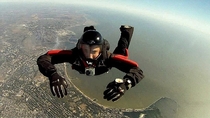
Parachuting
Parachuting, including also skydiving, is a method of transiting from a high point in the atmosphere to the surface of Earth with the aid of gravity, involving the control of speed during the descent using a parachute or parachutes. For human skydiving, it may involve a phase of more or less free-falling (the skydiving segment) which is a period when the parachute has not yet been deployed and the body gradually accelerates to terminal velocity. For cargo parachuting, the parachute descent may begin immediately, such as a parachute-airdrop in the lower atmosphere of Earth, or be significantly delayed, such as in a planetary atmosphere where an object is descending "under parachute" following atmospheric entry from space, and may begin only after the hypersonic entry phase and initial deceleration that occurs due to friction with the thin upper atmosphere.
See all
0
0
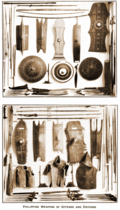
Filipino martial arts
Filipino martial arts (FMA) (Sining panlaban ng Pilipinas) refer to ancient and newer modified fighting methods devised in the Philippines. It incorporates elements from both Western and Eastern Martial Arts, the most popular forms of which are known as Arnis, Eskrima, and Kali. The intrinsic need for self-preservation was the genesis of these systems. Throughout the ages, invaders and evolving local conflict imposed new dynamics for combat in the islands now making up the Philippines. The Filipino people developed battle skills as a direct result of an appreciation of their ever-changing circumstances. They learned often out of necessity how to prioritize, allocate and use common resources in combative situations. Filipinos have been heavily influenced by a phenomenon of cultural and linguistic mixture. Some of the specific mechanisms responsible for cultural and martial change extended from phenomena such as war, political and social systems, technology, trade and practicality. Filipino martial arts have seen an increase in prominence due to several Hollywood movies and the teachings of modern masters such as Venancio "Anciong" Bacon, Dan Inosanto, Roland Dantes, Edgar Sulite, Cacoy Canete, Danny Guba, Mike Inay, Remy Presas, Wilson Pangan Sr. (Grand Master), Ernesto Presas Sr., Doug Marcaida, Ernesto Presas Jr., Carlito A. Lanada, Sr., and Carlos Deleon. There have been numerous scholarly calls on the inclusion of the many martial arts of the Philippines into the UNESCO Intangible Cultural Heritage Lists. As of 2019, a total of nine elements scattered in eight countries, such as Thailand, Georgia, and Korea, have successfully inscribed their martial arts in the UNESCO list.
See all
0
0
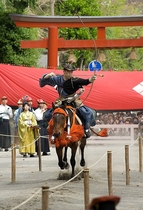
Yabusame
is a type of mounted archery in traditional Japanese archery. An archer on a running horse shoots three special "turnip-headed" arrows successively at three wooden targets. This style of archery has its origins at the beginning of the Kamakura period. Minamoto no Yoritomo became alarmed at the lack of archery skills his samurai possessed. He organized yabusame as a form of practice. Nowadays, the best places to see yabusame performed are at the Tsurugaoka Hachiman-gū in Kamakura and Shimogamo Shrine in Kyoto (during Aoi Matsuri in early May). It is also performed in Samukawa and on the beach at Zushi, as well as other locations.
See all
0
0

Varma kalai
Varma Kalai (Tamil: varmakkalai, Malayalam and Sanskrit: marma-vidya, Sinhala: maru kalā, Telugu: marma-vidya kaḷa) is a Tamil traditional art of vital points. It combines massage, alternative medicine, traditional yoga and martial arts in which the body's pressure points (varmam) are manipulated to heal or cause harm. The healing application called Vaidhiya Murai is part of Siddha medicine (siddha vaidyam). Its combat application is known as Adimurai (it includes a component called Varma Adi, meaning "pressure-point striking") can be done either empty-handed or with a blunt weapon such as a stick or staff. Varma Kalai is usually taught in the advanced stage of Adimurai, Kalaripayattu, and Silambam in Kerala and Tamil Nadu respectively; strikes are targeted at the nerves, veins, tendons, soft tissues or ligaments, organs and bone joints.test
See all
0
0
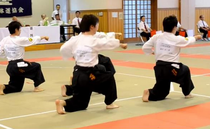
Taidō
Taidō is a Japanese martial art created in 1965 by Seiken Shukumine (1925–2001). Taidō has its roots in traditional Okinawan karate. Feeling that the martial arts, particularly karate, were not adapting to meet the needs of a changing world, Shukumine first developed a style of karate called Genseiryū around 1950. The Taidō is practiced in ten countries, including Japan, the United States, Australia, England, France, Portugal, Sweden, Finland, the Netherlands, Denmark and Norway. The martial art is particularly popular in Finland.
See all
0
0
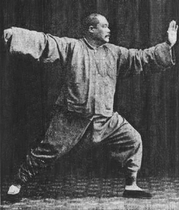
Tai chi
Tai chi , short for T'ai chi ch'üan or Tàijí quán (太極拳), is an internal Chinese martial art practiced for both its defense training, its health benefits and meditation. The term taiji is a Chinese cosmological concept for the flux of yin and yang, and 'quan' means fist. So, etymologically, Taijiquan is a fist system based on the dynamic relationship between polarities (Yin and Yang). Though originally conceived as a martial art, it is also typically practiced for a variety of other personal reasons: competitive wrestling in the format of pushing hands (tui shou), demonstration competitions and achieving greater longevity. As a result, a multitude of training forms exist, both traditional and modern, which correspond to those aims with differing emphasis. Some training forms of tai chi are especially known for being practiced with relatively slow movements. Today, tai chi has spread worldwide. Most modern styles of tai chi trace their development to at least one of the five traditional schools: Chen, Yang, Wu (Hao), Wu and Sun. All of the former, in turn, trace their historical origins to Chen Village.
See all
0
0
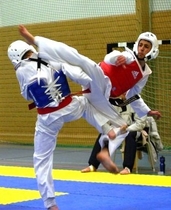
Taekwondo
Taekwondo, Tae Kwon Do or Taekwon-Do (Korean 태권도/跆拳道 ) is a Korean martial art, characterized by its emphasis on head-height kicks, jumping and spinning kicks, and fast kicking techniques. Taekwondo is a combative sport and was developed during the 1940s and 1950s by Korean martial artists with experience in martial arts such as karate, Chinese martial arts, and indigenous Korean martial arts traditions such as Taekkyon, Subak, and Gwonbeop. The oldest governing body for Taekwondo is the Korea Taekwondo Association (KTA), formed in 1959 through a collaborative effort by representatives from the nine original kwans, or martial arts schools, in Korea. The main international organisational bodies for Taekwondo today are the International Taekwon-Do Federation (ITF), founded by Choi Hong Hi in 1966, and the partnership of the Kukkiwon and World Taekwondo (WT, formerly WTF), founded in 1972 and 1973 respectively by the Korea Taekwondo Association. Gyeorugi , a type of full-contact sparring, has been an Olympic event since 2000. The governing body for Taekwondo in the Olympics and Paralympics is World Taekwondo.
See all
0
0
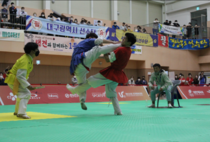
Taekkyon
Taekkyon, Taekgyeon, Taekkyeon, or Taekyun (Korean: 태껸/ 택견/ 托肩, ) is a traditional Korean martial art. It is characterized by fluid, dynamic foot movement called pum balki, or "stepping-on-triangles". Taekkyon includes hands and feet techniques to unbalance, trip, or throw the opponent. Taekkyon has many leg and whole-body techniques with fully integrated armwork. A Taekkyon practitioner is called a "Taekkyon-kkun". Since the twentieth century, Taekkyon has come to be seen as a living link to Korea's past. As such, it has provided historical references for modern Korean martial arts and is often considered as the oldest martial discipline of Korea. It was almost wiped out during the Japanese Occupation, before being rediscovered after the Korean War. It has influenced the name and conceptualization of Taekwondo.
See all
0
0
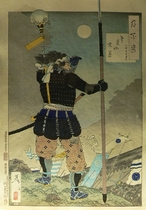
Sōjutsu
meaning "art of the spear", is the Japanese martial art of fighting with a .
0
0
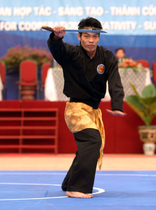
Silat
Silat is a collective word for a class of indigenous martial arts from the geo-cultural area of the Maritime Southeast Asia. It is traditionally practised in Brunei, Indonesia, Malaysia, Singapore, portions of the Philippines, Training halls are overseen by separate national organisations in each of the main countries the art is practised. These organisations are Ikatan Pencak Silat Indonesia (IPSI) from Indonesia, Persekutuan Silat Kebangsaan Malaysia (PESAKA) from Malaysia, Persekutuan Silat Brunei Darussalam (PERSIB) from Brunei and Persekutuan Silat Singapura (PERSISI) from Singapore. Practitioners are called pesilat. Both Pencak Silat and Silat Melayu are recognized as piece of Intangible cultural heritage by UNESCO (United Nations Educational, Scientific and Cultural Organization) in December, 2019.
See all
0
0

Shorinji Kempo
is a Japanese martial art claimed to be a modified version of Shaolin Kung Fu. The name Shōrinji Kempo is the Japanese reading of Shàolínsì Quánfǎ. It was established in 1947 by a Japanese martial artist and former military intelligence agent who lived in China for many years before and during World War II. Shorinji Kempo is a holistic system, whose training methods are divided into three parts: self-defence training, mental training and, health training. The basis are the concepts that "spirit and body are not separable" (心身一如: shinshin-ichinyo) and that it is integral to train both "body and mind as one" (拳禅一如: kenzen ichinyo). Through employing a well-organized technical course outline, Shorinji Kempo aims to help the practitioner "establish oneself" and to promote "mutual comfort". The philosophy and techniques of Shorinji Kempo are outlined in their master text, (少林寺拳法教範) Shōrinji-Kempō-kyōhan.
See all
0
0
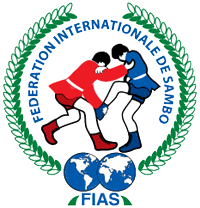
Sambo (martial art)
Sambo (са́мбо, ) is a martial art with Soviet origins, an internationally practiced combat sport, and a recognized style of amateur wrestling included by UWW in the World Wrestling Championships along with Greco-Roman wrestling and freestyle wrestling.
0
0
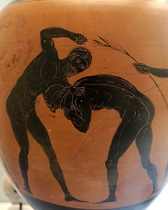
Pankration
Pankration (παγκράτιον) was an unarmed combat sport introduced into the Greek Olympic Games in 648 BC. The athletes used boxing and wrestling techniques but also others, such as kicking, holds, joint-locks, and chokes on the ground, making it similar to modern mixed martial arts. The term comes from the Greek παγκράτιον meaning 'all of power', from πᾶν (pan) 'all' and κράτος (kratos) 'strength, might, power'.
See all
0
0

Niten Ichi-ryū
{| border="1" cellpadding="2" width="300" cellpadding="2" cellspacing="0" style="float:right;clear:right;" |- ! colspan="3" bgcolor="#CCCEEE"| Arts taught |- | width="150" | Japanese name | width="150" | Description | width="150" | Niten Ichi-ryu designation |- | width="150" | Kenjutsu 剣術—odachi, kodachi | width="150" | Sword art—Long and short sword | width="150" | Tachi/Kodachi Seiho |- | width="150" | Kenjutsu—odachi, kodachi | width="150" | Sword art—Long and short sword used together | width="150" | Nito Seiho |- | width="150" | Aikuchi | width="150" | | width="150" | Aikuchi roppo |- | width="150" | Juttejutsu—Jutte | width="150" | Truncheon art | width="150" | Jitte to jutsu |- | width="150" | Bōjutsu棒術—Bō | width="150" | Staff art | width="150" | Bo jutsu |- |} which can be loosely translated as "the school of the strategy of two heavens as one", is a koryū (ancient school), transmitting a style of classical Japanese swordsmanship conceived by the warrior Miyamoto Musashi. Hyōhō Niten Ichi-ryū is mainly known for the two-sword—katana and wakizashi—kenjutsu techniques Musashi called Niten Ichi (二天一, "two heavens as one") or Nitō Ichi (二刀一, "two swords as one").
See all
0
0

Ninjutsu
sometimes used interchangeably with the modern term is the strategy and tactics of unconventional warfare, guerrilla warfare and espionage purportedly practiced by the ninja. Ninjutsu was a separate discipline in some traditional Japanese schools, which integrated study of more conventional martial arts (taijutsu) along with shurikenjutsu, kenjutsu, sōjutsu, bōjutsu and others. While there is an international martial arts organization representing several modern styles of ninjutsu, the historical lineage of these styles is disputed. Some schools claim to be the only legitimate heir of the art, but ninjutsu is not centralized like modernized martial arts such as judo or karate. Iga Ryu claims to be the oldest recorded form of ninjutsu, and claims to have survived past the 16th century.
See all
0
0
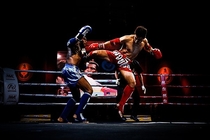
Muay Thai
Muay Thai (มวยไทย, ) or literally Thai boxing is a combat sport of Thailand that uses stand-up striking along with various clinching techniques. This discipline is known as the "art of eight limbs" as it is characterized by the combined use of fists, elbows, knees, and shins. Muay Thai became widespread internationally in the late 20th to 21st century, when westernized practitioners from Thailand began competing in kickboxing, mixed rules matches, as well as matches under Muay Thai rules around the world. The professional league is governed by The Professional Boxing Association of Thailand (P.A.T) sanctioned by The Sports Authority of Thailand (SAT), and World Professional Muaythai Federation (WMF) overseas. It is similar to related styles in other parts of the Indian cultural sphere, namely Lethwei in Myanmar, Pradal Serey in Cambodia, Muay Lao in Laos, and Tomoi in Malaysia.
See all
0
0
Pressure point
Pressure points derive from the supposed meridian points in Traditional Chinese Medicine, Indian Ayurveda and Siddha medicine, and martial arts. They refer to areas on the human body that may produce significant pain or other effects when manipulated in a specific manner.
See all
0
0
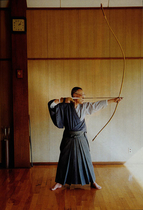
Kyūdō
Kyūdō (弓道) is the Japanese martial art of archery. Experts in kyūdō are referred to as . Kyūdō is based on kyūjutsu ("art of archery"), which originated with the samurai class of feudal Japan. Kyūdō is practised by thousands of people worldwide. As of 2005, the International Kyudo Federation had 132,760 graded members.
See all
0
0
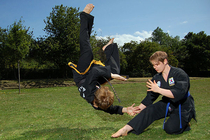
Kuk Sool Won
Kuk Sool Won is a type of Korean martial arts. It was founded in 1958 by Suh In-Hyuk (서인혁), who also carries the formal titles of, Kuk Sa Nim (i.e. "national martial arts teacher") and Grandmaster. This Korean martial art is known for its comprehensive collection of combat techniques, in particular, it teaches an extensive set of offensive and defensive moves designed to take advantage of the human body's many pressure points. Kuk Sool Won is practiced in various countries, with its biggest bases other than the South Korea and the United States being Western Europe (Germany, France, Italy and Spain) and Iran. However there is a strong following in South America as well.
See all
0
0
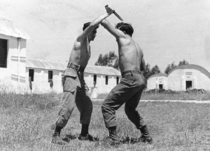
Krav Maga
Krav Maga (lit. "contact combat") is a military self-defence and fighting system developed for the Israel Defense Forces (IDF) and Israeli security forces derived from a combination of techniques sourced from boxing, wrestling, aikido, judo, and karate along with realistic fight training. Krav Maga is known for its focus on real-world situations and its extreme efficiency. It was derived from the street-fighting experience of Hungarian-Israeli martial artist Imi Lichtenfeld, who made use of his training as a boxer and wrestler, while defending the Jewish quarter against fascist groups in Bratislava, Czechoslovakia, during the mid-to-late 1930s. In the late 1940s, following his migration to Israel, he began to provide lessons on combat training to what was to become the IDF. From the outset, the original concept of Krav Maga was to take the most simple and practical techniques of other fighting styles (originally European boxing, wrestling, and street fighting) and to make them rapidly teachable to military conscripts. Krav Maga has a philosophy emphasizing aggression, and simultaneous defensive and offensive maneuvers. Krav Maga has been used by the Israel Defense Forces' special forces units, security forces and by regular infantry units. Closely related variations have been developed and adopted by Israeli law enforcement and intelligence organizations. There are several organizations teaching variations of Krav Maga internationally.
See all
0
0

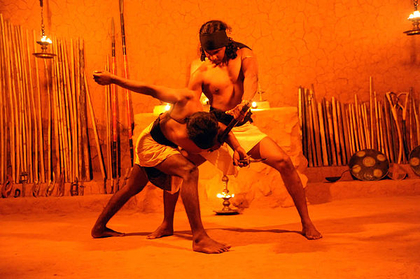




Comments